
A Cruise Ship Goes Down
Sinking of the Prinsendam in 1980 led to
One of history’s greatest maritime rescues
By DAVE KIFFER
October 10, 2015
Saturday AM
Ketchikan, Alaska - At the beginning of most cruise ship sailings, the passengers gather for a safety lecture. It's not really a drill because they don't get into lifeboats or rafts that are then cast off. What takes place is a muster drill in which passengers are told where to gather in an emergency and how to don a life vest.
After all, cruise ship sailings are statistically exceptionally safe. Millions of people travel on them every year and while occasionally ships have problems, a full evacuation is almost never needed.
Once a decade or so a cruise ship faces a more serious problem, rarely, if ever, are passengers faced with a situation in which they have to completely abandon ship and remember those details they learned in their "muster" drills.
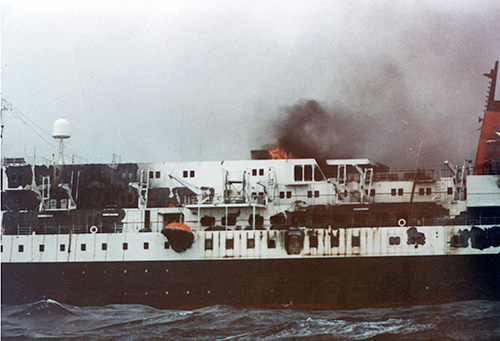
Sinking of the PRINSENDAM, October 4, 1980. The Prisendam was approximately 120 nautical miles south of Yakutat when the fire broke out.
U.S. Coast Guard Photograph
In fact, the nearly 1 million cruise passengers who visit Southeast Alaska yearly probably don't even give more than a passing thought to the chance their cruise may be interrupted by the multiple blasts of the ship's horn and the order from the captain to abandon ship.
But that is exactly what happened near Yakutat 35 years ago this month to one of ships in the Holland America fleet. A fire forced hundreds of passenger and crew of MS Prinsendam to abandon the ship before it sank in the Gulf of Alaska. No one died in the incident and some experts have labeled the evacuation one of the greatest in the history of maritime rescue.
On October 2, 1980, the Prinsendam left Ketchikan and headed to Glacier Bay before going into the Gulf of Alaska. Although the Southeast Alaska visitor season was over, the ship was on a special sailing from Vancouver, B.C. to Japan and other parts of Asia. It had made a single stop in Ketchikan, after leaving Vancouver.
By 2015 standards, the Prinsendam, at 427 feet, was tiny. Even in 1980, the ship was the smallest of the five in Holland America's fleet, although it was the newest and, in some ways, the jewel of the fleet. It had been built in 1973 at a cost of $50 million.
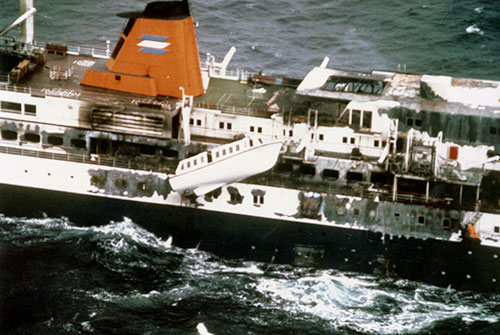
The Prinsendam was a 427-foot long cruiser liner built in 1973. The liner was transiting through the Gulf of Alaska, approximately 120 miles south of Yakutat, Alaska, at midnight Oct. 4, 1980, when fire broke out in the engine room.
U.S. Coast Guard photo.
Passengers on the Prinsendam had paid between $3,125 and $5,075 for the 29-day voyage from Vancouver through the Inside Passage and then across the North Pacific to Japan, Shanghai, Hong Kong and Singapore. Some of the passengers were going to stay on an additional two weeks as the ship visited Malaysia, Sumatra, Bali and Java.
Its total of 524 passengers and crew also seems miniscule compared to modern ships in the Alaska fleet that have six or seven times that number. But the difficulties encountered in safely evacuating even that relatively small number of passengers and crew point out just what trouble could await if a similar disaster happened to one of the leviathans in the modern cruise industry.
Still, the evacuation was also a blue print for just how to successfully deal with such a disaster at sea. It became, what Josh Reppinger called in a 1981 article in Popular Mechanics, the "most successful large scale peacetime sea rescue in history."
The Captain of the ill-fated Prinsendam, Cornelius Wabeke, had been a ship master for Holland America for 30 years and was one of the most experienced captains in the fleet. He would later be faulted for his response to the fire but not held solely responsible for the loss of his ship.
“Light rain greeted the Prinsendam as she eased into Ketchikan’s harbor early on Thursday morning, October 2 but the sky brightened to afford a day of sightseeing and shopping along the rustic boardwalk of Creek Street,” H. Paul Jeffers wrote in his 2006 book “Burning Cold: The Cruise Ship Prinsendam and the Greatest Sea Rescue of All Time.”
In his book, Jeffers noted that several passengers had a great time purchasing Native crafts and other items on Creek Street and elsewhere to take to loved ones back home.
“While the passengers were ashore in Ketchikan, the lifeboat crews practiced lowering boats,” Jeffers wrote. “When the Prinsendam was underway in the late afternoon, the sun was peeking through the clouds.”
Before arriving in Ketchikan, the passengers had a safety drill, according to Jeffers. They mustered in the lounge area and were shown how to don a life jacket or life vest and were told which life boat they were assigned to. According to the numerous passenger interviews that Jeffers used in his book, most of the passengers felt the drill had gone well and that they were prepared for any eventually. Of course, none of them really thought they would need to use that information.
Sailing north of Ketchikan, it was a typical day at sea. After dinner the passengers were treated to a variety show, which featured a young Greek musician who went by his first name, Yanni. Yanni would eventually become world famous as a new age keyboard player and the seller of millions of albums through direct sales on television.
On October 3, the ship arrived at Glacier Bay and the passengers enjoyed the day snapping pictures of the glaciers and the ice bergs.
As the ship turned out in the North Pacific on the evening of October 3, most of the passengers headed to their staterooms. Many were on their first trip in the open ocean and Dramamine was the popular nightcap of choice. There was a chance the ship might be bounced around by the remnants of a tropical storm in the next few days, but for now the sea was relatively quiet, especially for October.
Meanwhile down in the bowels of the ship, the engine crew was going about its nightly duties. While nothing is ever routine on a cruise ship, especially one with a four engine propulsion system, they were following the normal procedure of checking each of the multiple cylinders on the engines.
The oilers, greasers and other workers were hard at their tasks around 12:40 am when they saw a blue flame spark as a filter was being changed in a fuel line near one of the engines. A fire immediately broke out and efforts to fight it with fire extinguishers were unsuccessful. Soon the engine room was full of thick black smoke.
As the fire spread, the crew donned breathing apparatuses. It was clear that the fuel line was continuing to leak, making it impossible to contain the fire. Alerted to the problem, the Captain made the decision to try to fight the fire by flooding the engine compartment with carbon dioxide gas.
At the same time, Captain Wabeke had his signal operator send out the “XXX” code to the Coast Guard. The “XXX” code was less urgent than a “mayday” signal or an “SOS.” It merely reported to anyone listening that the ship had a problem, but not one of extreme severity. The message also reported the engine room fire.
The Prisendam was approximately 120 nautical miles south of Yakutat when the fire broke out. It was hundreds of miles away from the ships and planes that would need to rescue it. The Coast Guard rescue center - and its helicopters and aircraft were 250 miles to the west, Air Force rescue aircraft were at Elmendorf Air Base in Anchorage 370 miles to the north.
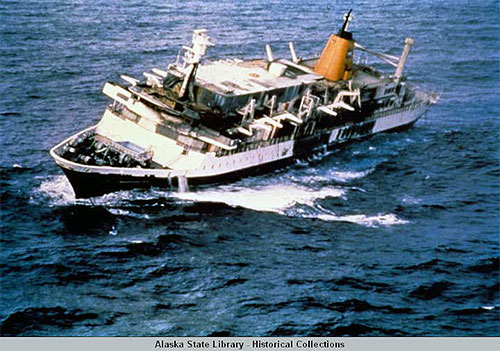
Sinking of the PRINSENDAM, October 4, 1980.
U.S. Coast Guard, 17th District, Photograph Collection, Courtesy Alaska State Library
Coast Guard helicopters were also available in Sitka 170 miles to the southeast. The nearest Coast guard cutters were the Boutwell in Juneau, some 300 miles away, and the Woodrush in Sitka. Other possible resources, in British Columbia, were also hundreds of miles away.
If the passengers and crew of the Prinsendam had to abandon ship, it could be hours, if not days before those ships and planes would reach them.
But there was a vessel much closer. A 1,000 foot supertanker, the Williamsburgh, had left Valdez with 1.5 million gallons of oil the day before and was some 90 miles south of the Prinsendam when it heard the distress signal. It turned around and began the five hour journey to rendezvous with the stricken cruise ship.
Other private vessels, farther away, also heard the distress call and changed course to find the Prinsendam. The 850-foot tanker Sohio was on its way from San Francisco to Valdez, and a container ship, the Portland, was on its way to Anchorage
"This is your captain speaking," several passengers later recalled hearing at just after midnight on October 4. "We have a small fire in the engine room. It is under control but for your own safety, please report to the promenade deck."
Many of the passengers later related they were first woken by the rumble of an explosion deep in the ship. There were several small explosions touched off the by the fire, shortly after those explosions the ship lost electrical power. Passengers could smell smoke in the corridors and soon the Captain had asked them to muster on the promenade deck. In the dark it was hard to dress and many passengers reached the promenade deck in odd assortments of clothes, some reportedly were even wearing draperies for warmth.
By 2 am, the main lounge on the Promenade Deck was beginning to fill with smoke and some passengers went out on deck to escape the smell. Some went into the Prinsen Club, a smaller lounge toward the bow. They were given snacks and free beverages. The gift shop was opened and sweaters were passed out. Ship entertainers continued to perform.
Shortly before 4 am, the passengers had to go out on deck because the smoke was filling the forward lounge.
Down in the hold, the firefighting efforts were not going well. The carbon dioxide system was working but not effective. The loss of electricity meant that there was no water pressure to fight the flames.
One thing in the ship's favor was that the weather was still calm. Although the remains of a tropical storm were just over the horizon, the Prinsendam was drifting in a calm sea, swells to five feet, winds of 10 mph, the air temperature was 57. Daylight would arrive in a few hours and - with help already on the way from a variety of directions - Captain Wabeke made the decision to abandon ship.
At 6:30 am, he announced: "I'm sorry, the fire is completely out of control, we have to abandon ship."
Given the relative old age of most of the passengers on board, the Captain decided to risk putting them in life rafts sooner rather than later, hoping that the bad weather would hold off and the rescuers would arrive. He knew that evacuating them directly from the ship in heavy seas would be nearly impossible. The fire was already spreading to other parts of the ship, it was starting to list as fire-cracked port holes were letting in seawater and he had no idea how much longer it would stay afloat.
Depending on which account you read, the evacuation either went smoothly or was chaotic. The vessel had six lifeboats that could hold 60-65 people and four large life rafts that could hold an additional 100 passengers. There were also two motor launches that were usually used to liter passengers in locations where the ship anchored in the harbor.
Clearly, there were problems loading some of the lifeboats. Unlike other famous evacuations it wasn't a case of rafts and boats leaving the ship half full. Some of the lifeboats were jammed with up to 90 people when they cast off. But with all the boats away, there were still 15 passengers and 25 crewmembers left on the stricken liner.
Fortunately, the Coast Guard and Air Force planes and helicopters began arriving on scene and with them were fire fighters brought to tackle the blaze and save the ship. But even the fire fighters had trouble. Their pumps were not sufficient, a large one was lost into the sea, and after an hour and a half, they conceded the battle was basically lost.
The best news happened at 7:45 am when the oil tanker Williamsburgh arrived on scene. The fact that it was fully loaded also was a good omen because it was riding lower in the water and it would be a little easier to transfer the Prinsendam passengers and crew to the giant tanker. Even so, passengers would have to climb up 40-foot rope ladders to get from the lifeboats and life rafts onto the tanker and given the age of many of the passengers that would have been a challenge. By 9 am, it was clear that the helicopters would have to hoist most of the passengers onto the tanker. Fortunately, it had a helicopter pad.
The helicopters quickly began hoisting the passengers - between 10 and 15 per load - on board and then transferring them to the Williamsburgh. It was a long process, according to Petty Officer Oliverson, a helicopter hoist operator, who spoke to Reppinger in 1981.
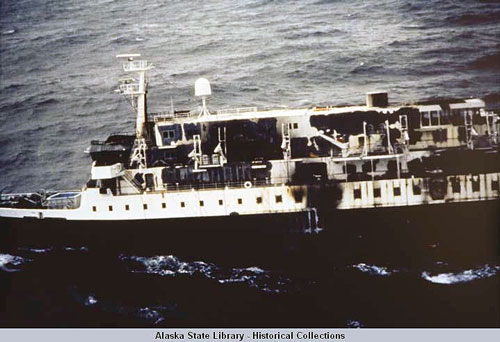
Sinking of the PRINSENDAM, October 4, 1980.
U.S. Coast Guard, 17th District, Photograph Collection, Courtesy Alaska State Library
"It took about three to five minutes to hoist one person 20-30 feet into the copter...The basket would be lowered into the lifeboat, someone would somehow crawl in, hold on for dear life, and we'd hoist him or her into the copter. Then another crew member would flip the basket over (crewman had to literally bang the knuckles of some frightened passengers to get them to release their grip) and then carry the person back in the copter where we tried to distribute the weight evenly."
When the helicopter was full, Oliverson said, the copter would go over to the Williamsburgh, drop off the passengers in about five minutes and then return to the life boats for another run. Occasionally, a helicopter would take a load of passsengers to Yakutat where it had to go to refuel.
Once on board the Williamsburgh, or the Coast Guard cutter Boutwell which arrived at mid day from Sitka, a team of doctors, nurses and other rescuers triaged the passengers deciding which ones needed more immediate care. Besides passengers suffering from exposure and motion sickness, there were also cancer patients, epileptics, even a passenger suffering from a malarial relapse. It was a testament to the skill of the responders that all the passengers eventually recovered.
By 6:30 pm it was announced that all the life boats and life rafts had been emptied and the Williamsburgh, with 380 Prinsendam passengers on board, was returning to Valdez, which was the only port large enough for it to dock. The Boutwell was heading back to Sitka with 80 passengers on board. By now the typhoon remnants - and its 35 foot seas and 40 knot winds was arriving.
But then the Air Force realized that some of its personnel were not accounted for. Another survey found that they were in a final lifeboat with 20 passengers. Night closed in as the storm began to rage. Because it was unsafe to continue to fly, the Boutwell turned around in hopes of finding the final lifeboat. Finally at 1 am, a cutter found the life boat and pulled the passengers and Air Force rescuers on board.
After the storm passed, the Prinsendam was still afloat. Coast Guard officials wanted to tow it to Juneau or Sitka, but Holland America demanded that it be towed to Portland instead. When it was some 70 miles west of Sitka, the end came.
"Debris covered the decks, the bridge was gutted, the hull and cabin-sides were scorched with ugly black streaks,” Eppinger wrote in 1981. “Smoke continued to drift from its innards. The Prinsendam listed dangerously as it took on more water through its blown-out portholes. Finally, just after daybreak on the overcast morning of Oct. 11, it rolled over on its side, resting there for a minute and a half, before sliding bow first to the bottom in 8,820 feet of water."
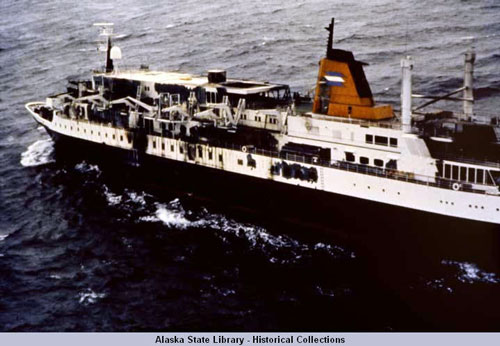
Sinking of the PRINSENDAM, October 4, 1980.
Description from Coast Guard: The cruise ship PRINSENDAM was abandoned 200 miles off the coast of Alaska, due to fire; over 500 passengers and crew were rescued; the ship sank seven days later
U.S. Coast Guard, 17th District, Photograph Collection, Courtesy Alaska State Library
Although the ship sank off the Alaskan coast, the inquest into the sinking took place in the Netherlands, the home of Holland America. The loss of ship prevented officials from a thorough investigation as to why the fire started and what could have been done to prevent its spread.
In general the inquest determined that fire drills on the ship were inadequate and that the Captain had delayed measures such as the use of carbon dioxide that could have been successful. Some fault was also laid at the feet of the vessel owners for being generally aware of the problem of occasional high pressure fuel line leaks.
Although the Captain was found to have some fault in the sinking, the inquest also determined that several of his crew members hadn't “served him well” in their responses to the fire and that he could not be blamed for the loss of his ship. Captain Wabeke’s license was suspended for several weeks and other officers on the ship also had their licenses suspended for up to two months.
The sinking also caused the Coast Guard to change some of its procedures, most notably working to make sure that its helicopters could be refueled on scene in the future and not have to fly hours to land for more fuel. The Coast Guard was also impressed by the skill of the Air Force rescue swimmers and that led to the formation of the Coast Guard’s own rescue swimmer program, which has been credited with saving hundreds of lives in the decades since.
On the official Coast Guard website, the successful evacuation of the Prinsendam is rated as its second greatest rescue operation, second only to the evacuation of more than 30,000 people during Hurricane Katrina on the Gulf Coast.
The rescue is also remembered every year when the Prinsendam Rescue Association meets in Seattle on the anniversary of the sinking. People who took part in the rescue most recently gathered from Oct. 2 to Oct. 4, 2015.
There is a Prinsendam currently in the Holland America fleet. In 2002, Holland America purchased the Seaborne Sun, which had been built in 1988, and renamed it the Prinsendam. The nearly 700 foot long ship carries approximately 1,200 passengers and crew. The ship offers "boutique" cruises to more out of the way tourism destinations such as the Black Sea, South America and Antarctica.
Edited by Mary Kauffman
Related:
The miracle rescue By PA1 Day Bosell
USGC Military History - Includes USCG Photographs of rescue...
http://www.uscg.mil/history/ops/sar/1980_PrinsendamCB.pdf
On the Web:
Columns by Dave Kiffer
Historical Feature Stories by Dave Kiffer
Dave Kiffer is a freelance
writer living in Ketchikan, Alaska.
Contact Dave at dave@sitnews.us
Dave Kiffer ©2015
E-mail your news &
photos to editor@sitnews.us
Publish A Letter in SitNews Read Letters/Opinions
Contact the Editor
SitNews ©2015
Stories In The News
Ketchikan, Alaska
|
Articles &
photographs that appear in SitNews may be protected by copyright
and may not be reprinted without written permission from and
payment of any required fees to the proper sources.
|
|

